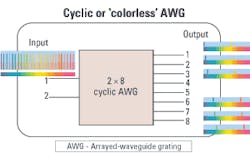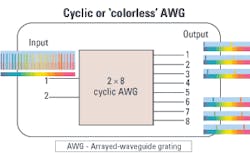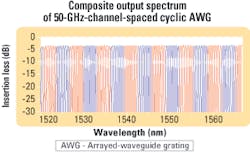New developments improve AWG’s business case
New developments in arrayed-waveguide-grating (AWG) technology have allowed AWGs to regain dominance in high-channel-count applications and earn significant share at low channel counts. AWGs provide optical multiplexing and demultiplexing in DWDM systems, efficiently placing 40 or even 80 different DWDM wavelengths onto an optical fiber and extracting those wavelengths at the other end of the transmission. Thus, a 40-channel AWG replaces 40 different discrete thin-film filters (TFFs) in one compact package.
However, planar lightwave circuits (PLCs), the technology that enables AWGs, can perform many other functions besides multiplexing and demultiplexing, including splitting, switching, monitoring, and variable optical attenuation. In fact, PLCs incorporating more than 100 different functions on a single chip have now been developed.1
Future optical systems will be constructed out of such integrated “optical systems on a chip” in much the same manner that electronic ICs replaced transistors. For that to happen, the performance of the individual integration building blocks must be competitive with discrete solutions. Thanks to new designs, this goal is being met, and AWGs are taking market share from TFFs in a widening range of applications due to their superior cost and performance.
PLC technology was first commercialized during the telecommunications boom of the late 1990s to bring semiconductor-style manufacturing to the fiber-optic components industry. The great advances in optical-network technology that increased the practical capacity of a single fiber from a few hundred megabits per sec to a terabit per sec or more were largely carried out with discrete optical components, each performing one function and assembled and packaged individually. However, discrete components were expensive and difficult to scale to the volumes and complexity envisioned during the boom years. PLC technology enables optical ICs to be mass manufactured using the same tools and equipment used to make electronic ICs, simultaneously increasing functionality and decreasing costs.
The first PLC product to achieve widespread commercial deployment in telecom systems was the AWG. AWGs were ideal for the telecom boom mentality, which pushed to ever-higher channel counts and higher capacity. However, the telecom bust of 2001-200? drastically changed the economic environment of the fiber-optic components business. AWGs are by far the best technology for multiplexing and demultiplexing of high-channel-count DWDM systems, having the lowest cost per channel, lowest loss, and highest uniformity. AWGs are an integrated system, and the cost and performance are nearly independent of channel count. Discrete TFFs, on the other hand, increase in cost and degrade performance essentially linearly with channel count, since each new channel means a separate new filter.
That was a dominant advantage for AWGs during the boom times when it was thought that systems would quickly utilize all channels due to the explosive growth of traffic. During the telecom bust, when it became clear that traffic would grow at a more even rate, the dominant factor in system deployments became “first-in costs.” In other words, carriers wanted to install the first channel at the lowest possible cost. The costs of additional channels were less important since those channels would only be used in the event that there was traffic to justify the expense of installing them.
This change worked against AWGs for two reasons. First, since AWGs are integrated, all of the channels in the AWG have to be installed at the beginning, increasing first-in costs. (Of course, the transceivers do not have to be installed, so that only represents a small fraction of the cost of “lighting” a channel. Still…) Secondly, AWGs required active temperature control to remain centered on the ITU grid. The cost of supplying power to the shelf or rack is minimal when amortized over 40 channels but is significant for first-in cost. Even though AWGs remained the best solution for overall lifecycle costs, small-channel-count TFF blocks began to look good again due to their first-in-cost advantage.
However, PLC vendors have not remained passive in the changing telecom economic environment. Several key improvements have been made in AWG technology that have enabled AWGs to compete and win in the new circumstances. First, AWGs are a relatively new technology, and great improvements in optical performance have been made over the last few years. For example, the insertion loss of a wideband AWG has been cut nearly in half and the passband has been widened by more than 50%, making AWGs competitive at lower channel counts. Second, yields have increased and costs have been dramatically lowered, making the first-in-cost penalty for a full 40-channel AWG very small. For these reasons, many equipment vendors, particularly in Asia, have adopted AWGs as a standard and therefore enjoy the lowest lifecycle costs.
Two other advances have enabled AWGs to move into territory previously occupied by TFFs. The first is the development of a cyclic or “colorless” AWG that can work in any channel band, replacing up to 12 different parts with one interchangeable part, thereby greatly simplifying inventory management. The second is an “athermal” AWG that does not require any electrical power or active temperature control. These two new AWG designs eliminate any advantages that TFFs had and offer new advantages that TFFs cannot match, accelerating the acceptance of AWGs in all market segments.
When installing long-haul fiber-optic networks today, carriers want the lowest possible first-installed costs, meaning they only want to install a few channels to begin with. But to avoid being caught short in the future, they also demand that the system be expandable to the full 80-96 channels achievable in the C-band with 50-GHz spacing. These conflicting demands mean that component vendors must make and equipment vendors must stock up to 96 different filters, even though only a few are likely to be used.
To balance the loss, these filters are usually deployed in blocks or bands of typically eight channels, which are combined by banding filters. There are 12 different bands of eight-channel blocks in a 96-channel plan. Most carriers will install only one band in a system to start and add more bands as traffic growth demands. However, parts must be procured and part numbers tracked for all 12 bands, adding to material procurement and inventory management costs.
AWGs offer a simple and cost-effective solution to this problem. As the name implies, AWGs are a form of optical grating, and constructive interference occurs when the path-length difference equals an integer number of wavelengths (=nλ, where n is the “order” of the grating). Constructive interference will also occur when n+1 or n-1 wavelengths are matched. It is possible to design an AWG where order n matches band 1, order n+1 matches band 2, order n+2 matches band 3, and so on. In this case, the free spectral range (FSR) of the AWG exactly matches the spacing between the different bands.
Such AWGs are called cyclic or “colorless” since they will work in any band. A diagram of such an AWG is shown in Figure 1. In this case, to smooth out the insertion loss of all channels, one input is used for the odd bands and a second input is used for the even bands.Since only one part number is required, no matter what channel plan the customer chooses or what additional channel upgrades are selected, the cost of inventory management and sparing is reduced by as much as 50%. As an additional benefit, AWGs exhibit far lower and flatter chromatic dispersion in 50-GHz-channel-spaced systems when compared to TFFs or fiber Bragg gratings.
The index of refraction of the type of glass used to make AWGs varies in such a way that the center wavelength of an AWG channel will drift approximately 11 pm/°C. In standard AWGs, this drift is eliminated by using active temperature stabilization to keep the AWG channel on the ITU grid. The AWG chip temperature must be stable to better than ±1°C to avoid affecting system performance. Some techniques have been developed to passively compensate this temperature drift, but most caused some degradation in the AWG filter performance. During the telecom boom, performance was the dominant consideration, and few system designers chose to accept the system penalty of athermal AWGs to eliminate the electrical power. Now, however, every cost is important.
A new type of practical and robust athermal AWG has been developed that mechanically compensates the temperature drift of the grating with the same high performance as a standard AWG.2 AWGs are in effect very-high-quality interferometers with a typical wavefront accuracy of better than λ/200. That means all parts of the AWG must be so perfect and free of defects or nonuniformities that the error in phase of any part of the light will be less than 2 degrees. Unlike many of the approaches to athermalization, this new approach does not disturb the wavefront by removing some of the light from the pure glass, but rather mechanically moves the waveguides to “catch” the proper wavelength channels.
Figure 3 shows a plot of the difference between the channel center wavelength and the ITU grid (ITU-OFF) versus temperature for this newer type of athermal AWG. The ITU-OFF values are the equivalent of stabilizing a standard AWG to ±1°C over a temperature range of 0°-60°C, and ±1.5°C over a temperature range of -30° to +70°C. That marks the first athermal AWG that combines the high performance and low cost of standard AWGs with no requirement for electrical power.Athermalization technology opens two major new market areas to AWGs. First, AWGs can now be used as drop-in replacements for TFF DWDM multiplexer/demultiplexer modules in cases where no electrical power is available on the shelf or in cases where the additional power required to stabilize the AWG is undesirable. Such DWDM devices are typically used in long-haul and metro networks, which could now benefit from the low cost and high performance of AWGs. That represents a substantial, if not so rapidly growing, market.
A second and potentially much larger market is emerging in new proposals for WDM-PON systems such as that recently announced by Korea Telecom. These systems would use athermal AWGs in very large numbers to provide >100-Mbit/sec service in fiber to the home (FTTH) applications, and they require outdoor operation over -30° to +70°C. Residual drift in TFFs as well as high cost makes them unsuitable for outdoor operation in WDM-PON applications.
The great progress in AWG performance and cost reduction, along with the development of cyclic and colorless AWGs, has allowed AWGs to regain their momentum of the boom years and gain market share in segments previously dominated by TFFs. However, AWGs are just one product that can be manufactured using PLC technology. Integrated products such as variable-optical-attenuator multiplexers, blockers, and reconfigurable optical add/drop modules that combine multiple different functions onto a single PLC chip are emerging in the market due to their performance and cost advantages. At the same time, PLC-based hybrid transceivers like triplexers for FTTH that combine waveguide chips with active lasers and photodetectors are under development by several companies.
The future of the fiber-optic components industry lies in the combination of these two ends of the PLC spectrum to produce multifunctional, highly integrated “optical systems on a chip.” AWGs are a key building block for these new integrated modules, and recent advances have shown that they are ready to carry their weight.
G. Ferris Lipscomb is vice president of marketing at NeoPhotonics (San Jose, CA).
- J. Lam, A. Liu, and M. Yan, “Multi-Function Integrated AWG Devices,” published last month at OFC/NFOEC in Anaheim.
- A.J. Ticknor, B.P. McGinnis, T. Tarter, and M. Yan, “Efficient Passive and Active Wavelength-Stabilization Techniques for AWGs and Integrated Optical Filters,” published last month at OFC/NFOEC in Anaheim.



